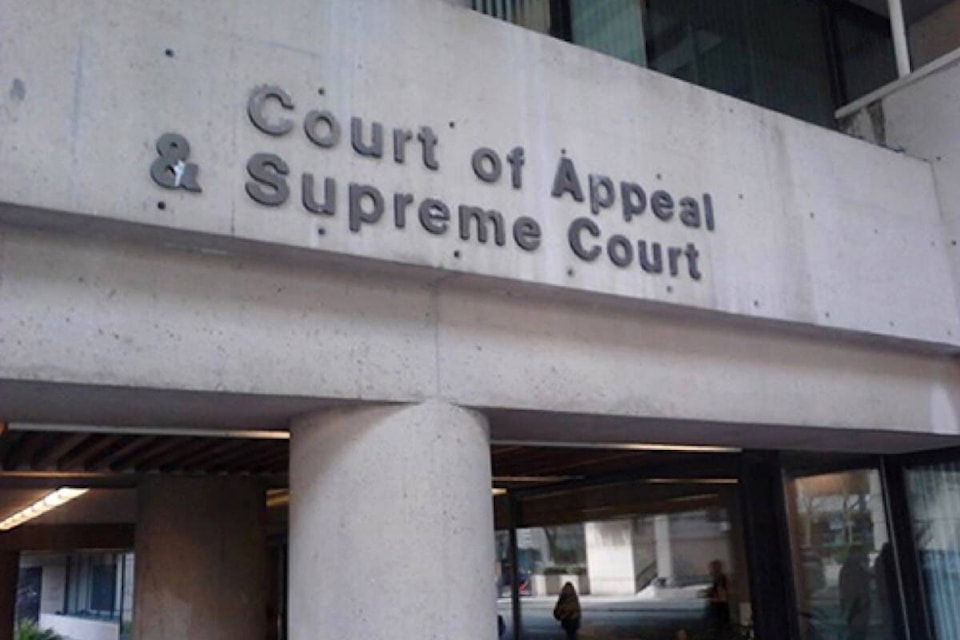A man convicted of causing the death of one passenger and injuring two others while stunt driving near Deroche succeeded at the B.C. Court of Appeal and is now facing a new trial.
Brennan Rogers of Port Moody was 19 on the afternoon of Aug. 13, 2016 when he was driving his Jeep Cherokee with his dog and three friends to a campsite near Deroche.
The four of them had been celebrating the life of another friend who had recently died while hiking in the area.
One passenger, referred to in the Appeal Court written decision as 26-year-old Mr. Carpenter, died at the scene. Two others were injured.
After a five‑day trial in July 2020, Rogers was found guilty by a judge of dangerous driving causing death and two counts of dangerous driving causing bodily harm. The judge found that the appellant had intentionally tried to “drift” or fishtail his vehicle at a turn in the road and that this “amounted to a marked departure from the standard of care expected of a reasonable driver in the circumstances.”
Rogers and his lawyer argued that the convictions were the product of a miscarriage of justice by reason of numerous misapprehensions of fact by the judge, and that the judge also made an error in law.
RELATED: 23 months jail for 2017 crash that killed woman near Hope
RELATED: Charter breach leads to dismissal of charges in 2010 impaired driving causing death case
Crown acknowledged two errors of fact in the trial judge’s reasons, but suggested they were of a technical nature and harmless to the decision given the weight of evidence against the appellant.
At trial, Rogers admitted that he was drifting or fishtailing around some corners on the Cheahlis Forest Service Road near Harrison Mills while driving the Jeep to the campsite back from Deroche after picking up supplies. At the site of the accident, however, he said he was not drifting but rather he simply lost control after accidentally skidding. The vehicle went over an embankment, rolling over several times down towards a ravine.
“Mr. Rogers did not lose consciousness and was able to walk away from the car, as was the dog. The appellant’s passengers were not so fortunate.”
The trial judge rejected Rogers’ evidence as “self‑serving and in polar opposition” to the photographic evidence, the expert evidence, and the testimony of one of the injured passengers, Tomasz Grochowicz.
“The judge concluded on the totality of the evidence — ‘that is speed coupled with the makeup of the roadway, its surface, and the curvature, along with the accused’s knowledge of the characteristics of the vehicle’ — that the Jeep had been driven in a manner that was objectively dangerous,” according to Appeal Court Justice Mary Newbury, who wrote the decision.
But the Court of Appeal agreed with Rogers that the trial judge made a number of errors regarding the evidence heard at trial.
One example was that the judge inferred Rogers had a propensity to speed from evidence of his driving the day before. Rogers explained he had been keeping up with a convoy of other vehicles the day before, but the judge didn’t explain why that was ignored.
The judge also concluded that Rogers told Grochowicz to hang on to his dog “just before the accident, in the moments before what Mr. Grochowicz described as the accused’s attempt to drift the vehicle.” But Grochowicz only testified that “at one point told me to hold onto his dog, because his dog was sitting between me and Alex and the dog was getting tossed around a bit.”
“In the judge’s analysis, this seems to have supported the inference that the appellant intended to ‘drift’ the Jeep,” but the judge did not nail down when the “hang-on-to-the-dog” comment was made.
The judge also concluded that Rogers had not braked before the rollover. The judge went further, stating that braking would have stopped the vehicle despite the fact that no expert testified to this.
“In my respectful view, the trial judge did err on this point and the error was material to his conclusions,” Justice Newbury wrote.
The trial judge clearly disbelieved Rogers’ evidence, but even with that, he was then required to consider whether a reasonable doubt remained.
“His apparent failure to do so did in my view constitute an error of law that added to the cumulative effect of the misapprehensions of evidence discussed above. In my respectful view, the end result was at the least to create the appearance of unfairness, if not to render the trial unfair.”
Justice Newbury wrote that she “readily acknowledged” that the trial evidence could have supported guilty verdicts, but she was unable to conclude that the verdicts would have been the same without the errors.
“Accordingly, I would allow the appeal, set the convictions aside, and order a retrial.”
Rogers is next scheduled in court on Feb. 21 to schedule a new trial date.
Do you have something to add to this story, or something else we should report on? Email:
editor@theprogress.com
Like us on Facebook and follow us on Twitter.
